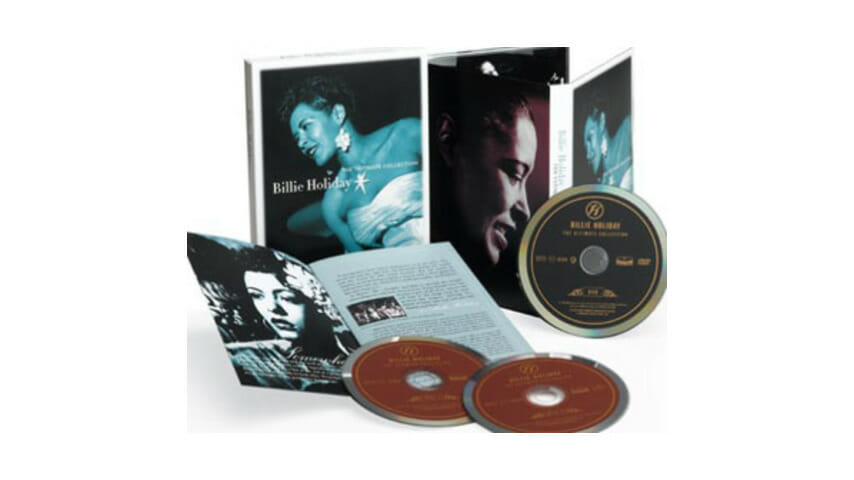
Beautiful Day: New set pays tribute to jazz’s beloved crown jewel
In December 1957, appearing on a CBS television special on jazz, Billie Holiday looks on as some of the best jazz soloists of her day try to impress her on “Fine And Mellow.” By that point in her life, Holiday’s singing voice had long since taken on a raspy, smoke-stained tint, and her health was quickly deteriorating, but you couldn’t have convinced Lester Young, Coleman Hawkins or Roy Eldridge she’d lost a thing. The three legendary instrumentalists, though towering musical figures in their own right, line up to deliver personal offerings of respect and love to their Lady (Young actually gave Holiday the nickname “Lady Day”) and sometimes appear nervous as schoolboys on parade in front of the prettiest girl in school. Trumpeter Eldridge cracks a note, but nails the high one at the end; alto-saxophonist Hawkins keeps things nice and smooth, ever the gentleman; tenor man Young plays the blues, and elicits the most appreciative response from Holiday, as she rocks back and forth to his phrases and sweaty brow. It spurs him on. Even in her final years, Billie Holiday was a wanted woman.
The Ultimate Collection makes yet another case for Holiday’s continuing appeal. It contains two discs of music and a DVD with archival audio and video material spanning Holiday’s 25-year recording career. More than that, it clarifies why so many people found her fascinating, tragic and just plain cool. Despite its stated intent (“No interpretation, filter or framing”), the set reveals an artist mostly blue on record, though with a grin, as if the travails of her life never quite got the best of her emotionally. Of course, Holiday has been dead for over 45 years, and given the number of compilations currently available, one might understandably count the book just about closed for further consideration. Even so, this blandly titled set surprises, since for the first time in America, listeners have access to a sampling of her entire recorded output, label by label, mono to stereo, big bands, jazz combos and all. The video footage is a marvel, but perhaps even more valuable to fans are the audio interviews, detailed timeline and hundreds of still images.
The audio CDs are arranged chronologically, beginning with two songs from a June 1935 session with pianist Teddy Wilson’s band (including Eldridge and legendary clarinetist Benny Goodman), “Miss Brown to You” and “What A Little Moonlight Can Do.” These songs, though not necessarily what Holiday is remembered for, are interesting both as time capsules (Goodman’s opening solo on “What A Little Moonlight Can Do” should be preserved in the Smithsonian) and because they demonstrate how Holiday, even relatively green as a recording artist, had already found her voice as a singer. Needless to say, standards like “Strange Fruit,” “God Bless the Child” (Holiday’s argument-settling response to her mother), “Don’t Explain” and the gorgeous, string-laden “Lover Man” are all represented here, and retain their practically timeless spark, even after decades of canonization by jazz, soul and pop musicians and fans.
The second half of Holiday’s career found the singer in the midst of celebrity, though some argue her music drifted closer to pure pop from the intimate jazz-club settings of her youth. Certainly, brassy big-band recordings like “Them There Eyes” and “You Can’t Lose A Broken Heart” (a duet with Louis Armstrong) offer a slightly more extroverted side of Holiday than is typically emphasized by fans and historians. More typical are the laid-back, smoky small-group tunes like “Detour Ahead” (a rarity pulled from a brief period in the early 1950s after leaving Decca and before signing with Verve), “You Go to My Head” (featuring pianist Oscar Peterson), “Willow Weep For Me” and “It Had to Be You.” Even “Lady Sings the Blues,” with its brash opening-trumpet fanfare, writhes in the behind-the-beat phrasing and comfortable soul Holiday practically invented.
The DVD contains film and television appearances, including the aforementioned performance of “Fine And Mellow” and a proto-music video performance of “Saddest Tale” from Duke Ellington’s 1935 Symphony In Black: A Rhapsody Of Negro Life, among others. Fans may want to skip straight to the audio interviews, though, as Holiday’s time with a pre-60 Minutes Mike Wallace in 1956 will doubtlessly enthrall those who prefer to hear news directly from the source. Furthermore, her admirers get in their two cents via candid archival interviews (culled from late writer Linda Kuehl’s never-completed biographical project on Holiday), including jazz greats Jo Jones, Billy Eckstein and Eldridge.
And of course the ride ends far too soon. It would be hard to encapsulate the entirety of Holiday’s legacy into three polycarbonate plastic discs, no matter the content, but The Ultimate Collection succeeds admirably on its terms. Consider it a starter set, and take your place in the line of admirers.